
Much of this canyoneering glossary was adapted from http://www.bogley.com/forum/showthread.php?21603-Canyoneering-Glossary
| Term | Definition | |
|---|---|---|
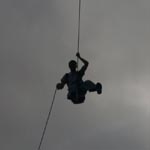 |
Abseil | Sliding down a rope under control, known as rappelling in the dear old USA. |
| Aid Climbing | The use of anything other than the natural rock features. | |
| Alpine Style | Refers to canyoneering in a self-sufficient manner, thereby carrying all ones food, gear, ropes, equipment etc. as one descends the canyon. As opposed to siege style or (expedition style). | |
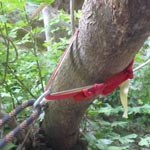 |
Anchor | Point where the rope is secured to the rock with bolts, rocks, slings,trees or other gear. |
| Arete | A narrow ridge. | |
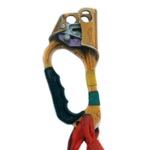 |
Ascenders | Mechanical devices used to ascend a rope. |
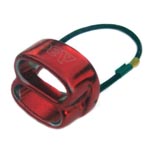 |
ATC | Air Traffic Controller. Type of descender/belay device. |
 |
Batman | To climb the rope hand over hand with a supporting surface for the feet. |
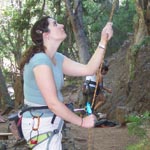 |
Belay | To secure a climber or rappeller with a rope. |
 |
Beta | Insider information or advice about a route given by one (or quite often 6) self-proclaimed experts. From Betamax, and an article in Rock and Ice Magazine by Neil Cannon, circa 1987. |
 |
Biner | Short for carabiner. |
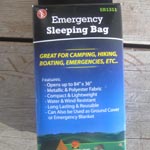 |
Bivouac, Bivi | A very uncomfortable sleeping place in the middle of a route. French for "We really screwed up". Also slang for a lightweight emergency sleeping bag. |
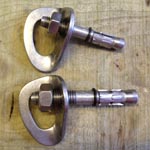 |
Bolt | An expansion bolt used by gumbies to simplify or dumb down a route. |
 |
Bombay | A wide silo or bell shaped void directly under a very narrow section in a canyon. The narrow section above is safely stemmable down to where the bombay opens up. At that point, the canyon is no longer stemmable. Further descent must be achieved through rappelling (or falling). |
| Bomber | Used to indicate that something is exceptionally solid. | |
| Bombproof | The illusion that an anchor is infallible. | |
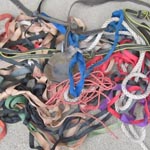 |
Booty | Gear (biners, nuts, rope, cams, etc.) that was left behind by the previous party. |
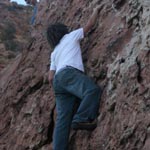 |
Bouldering | Climbing unroped on boulders or at the base of climbs to a height where it is still safe to jump off. |
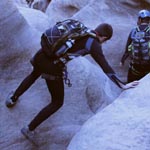 |
Bridging | Involves hands on one side, feet on the other, facing down. |
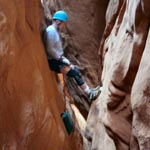 |
Bunny Strap | A length of webbing or a daisy chain with a carabiner attached which will allow you to hang your pack from your harness while you chimney, climb and stem. Can also double as a cowstail. |
 |
Buttress | The part of the mountain or rock that stands in front of the main mountain face. |
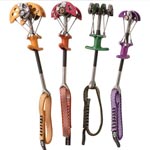 |
Cam | A spring loaded camming device is a piece of rock climbing or mountaineering protection equipment. It consists of three or four cams mounted on a common axle or two adjacent axles, so that pulling on the axle forces the cams to spread further apart. By pulling on the"trigger" (a small handle) so the cams move together, then inserting it into a crack or pocket in the rock and releasing the trigger to allow the cams to expand. At this point a climbing rope can be attached to a sling and carabiner at the end of the stem. |
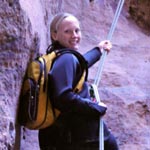 |
Canyonette | Female canyoneer. |
 |
Carabiner | A metal snap-link used for purposes such as attaching climbers to anchors. This most essential climbing device is also known as a biner. |
 |
Cheater Stick | (Happy Hooker) A long pole with a hook attached to one end. |
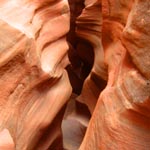 |
Chimney | A wide crack that accommodates the body of the climber. |
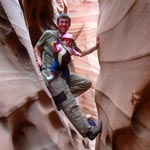 |
Chimneying | Involves feet on one side, back on the other, more or less facing sideways or up. |
 |
Chockstone | A stone wedged into a crack or chimney. Can be very small to gigantic. |
| Chossy | Loose or bad quality rock. | |
| Chute | A very steep gully. | |
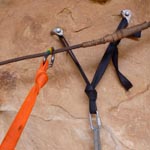 |
Clip In | The process of attaching to belay lines or anchors for protection. |
| Couloir | A steep gully which may have snow or ice. | |
 |
Cowstail | A length of dynamic rope with a carabiner attached that allows you clip into an anchor for rebelays or hang a pack from. Plural cowstails refers to a long and a short rope. |
| Crux | The hardest part of the route. | |
 |
Daisy Chain | A sling sewn with numerous loops. |
 |
Deadman | A natural anchor consisting of a large stone wrapped with webbing and buried just above a rappel. Or what you may become if your natural anchor fails. |
| Diversion | An additional anchor part way down that changes the angle/position of the rope. If the original anchor fails, the rope will slide right through the diversion. | |
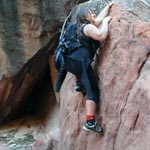 |
Downclimbing | What skilled canyoneers do instead of rappelling. |
| DRT | Double Rope Technique. | |
| Elevator(noun) | a short section of slot or chimney which provides the right geometry to allow one to elevator down. | |
| Elevator(verb) | to descend vertically a slot or chimney of arbitrary height by means of sliding, employing sufficient friction to do so in a controlled fashion, and possibly intermixing other maneuvers. Usage: "One can elevator down here." | |
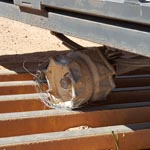 |
Epic | The story of a well planned trip that turned into a grueling adventure that turned out well in the end. As these stories are told over and over again - and they always are - the details get stretched to supernatural proportions for dramatic effect. |
 |
Etrier | Webbing ladder used for aid climbing. Aka 'aider'. |
| Exposure | Being in a situation in which you are very aware that you are high off the ground or in a remote location. | |
| Fanboy | (Fanboy or Fangirl) Someone who is hopelessly devoted to something and will like anything associated with it. Term related to forum users who think a product/company/person can do no wrong. | |
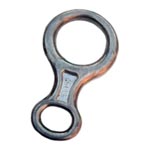 |
Figure8 | Metal rappelling/belaying device shaped like an 8. |
 |
Fixed Pro | Bolts, rings, pitons and other pieces of unremovable protection that maybe found in a canyon. Use at your own risk. |
 |
Free Rappel | Rappelling from an overhang without touching the wall. |
| Galumphing | Moving rapidly down canyon using stemming, and swinging the body under the arms to be caught by the feet, or a foot/butt stem. | |
| Ghost | To complete a route leaving no evidence of your passage other than footprints. | |
| Gully | A wide, shallow ravine on a mountainside. | |
| Gumbie, Gumby | An inexperienced or new canyoneer. Unlike posers, gumbies don't know enough to get hurt. | |
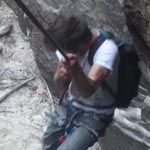 |
Handline | Downclimbing with the use of a rope gripped in one or both hands. |
| Hand-over-Hand | Climbing up or down a rope without the use of feet. | |
 |
Happy Hooker | A long pole with a hook attached to one end. Aka Cheater Stick. |
| Hardman | A canyoneer with seemingly superhero strength who has survived epics of grandiose proportions. | |
 |
Harness | Piece of clothing that identifies you as a climber. Hanging things from the harness that make a loud clanking sound can significantly enhance the coolness factor. |
| Historian | Somebody who likes to think they know what they are talking about when discussing "the old days". | |
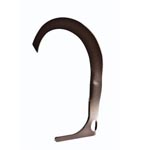 |
Hook | A devise used in aid climbing. |
| House Cat | Canyoneering instructor who no longer descends canyons. | |
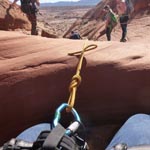 |
Human Anchor | Where a rappel is necessary, and in the absence of rock bolts or other reliable anchors, a rope may be secured to a fellow canyoneer (usually the heaviest, or most skilled in the group) in order to provide a way for the rest of the group to rappel to the base of the drop. Also called a meat anchor. |
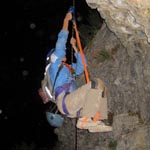 |
Jug | To climb the rope with some type of ascenders. |
 |
Jumar | A type of rope ascending device. |
| Keeper Pothole | A pothole that is too deep to scramble out of without the assistance of specialty pothole escape techniques (i.e., partner assist, potshot, pack toss,or happy hooker). | |
| Kelsey Exit | An exit marked in one of Kelsey's books. May be a brilliant exit from a canyon with few exits; may be a dangerous and as-yet untried potential escape route. | |
| Kiddie Canyoneer | A canyoneer who only does Rap-N-Swim (beginner) canyons. | |
| LAMAR | LAst Man At Risk. | |
| LDC | Looking Down Canyon or Left Down Canyon. | |
| Ledge | Flat bit on a rock that can be miniature or gigantic. | |
| Left | Can mean "right", depends where you are looking. | |
| Li-loing | To float on an air mattress or small raft down-canyon. | |
 |
Locking biner | Carabiner that can be locked. |
| LUC | Looking Up Canyon or Left Up Canyon. | |
| Luggage | A group member who is a burden to the group. | |
 |
Mae West | A slot canyon so narrow that it is impossible to pass through. Usually requires climbing over with major exposure. |
| Mantle | Difficult balancing move useful to get up on ledges. | |
| Martin Lawrence Section | A long stretch of dry canyon done while wearing a wet suit. Actor Martin Lawrence was hospitalized for kidney failure after jogging around LA wearing a wetsuit to lose weight. | |
 |
Natural Anchor | Trees, rocks, or gear that is placed in cracks, pockets or around objects so that it can be removed with no harm to the rock. |
| Noobie, Noob | A new canyoneer. | |
| Pack Toss | Throwing a full backpack with a rope attached to the escape side of a keeper pothole in order to assist escape. | |
| Passenger | A group member who is neither an asset nor a burden. | |
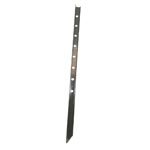 |
Picket | A natural anchor consisting of several metal stakes, sticks, or other objects jammed into the ground in sequence, each tied together. |
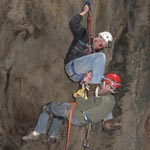 |
Pick-off |
A rescue technique where the rescuer hangs an incapacitated person from his harness and hauls him up the rope with him. |
| Pitch | A section of climb between two belays and no longer than the length of one rope. | |
 |
Piton | Metal spike hammered into a crack. |
| Poach | To complete a route without the proper permit, permission and/or authorization. | |
| Poser | A novice canyoneer who thinks he knows it all. | |
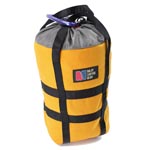 |
Potshot | A small but durable bag that is filled with sand or rocks which is then tossed on the escape side of a keeper pothole, in order to assist escape. |
| Protection, Pro | Anchors placed in the canyon to protect the canyoneer. | |
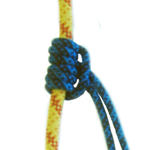 |
Prusik | A sliding knot method used to ascend a rope. Does not necessarily involve using the Prusik knot. |
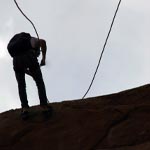 |
Pull Cord | A rope used to retrieve a fixed rappel line. Typically pull cords are more light-weight than rappel lines, and are used exclusively for the retrieval of fixed rappel ropes after descending. |
| R rating | Risky. A subjective rating system used to rate canyons that are made more hazardous than an average canyon by the presence of bombays, keeper potholes,dangerous and/or exposed downclimbing, long exposure to cold water, and/or the need for advanced ropework in order to safely descend. A major mishap may result in serious injury. | |
| Ramp | An ascending or descending ledge. | |
 |
Rap-N-Swim Canyon | A beginner canyon, the only difficulty in the canyon is rappeling and swimming. A term often associated with canyons in Zion National Park. |
 |
Rappel, Rap | Sliding down a rope under control, known as abseiling outside the USA. |
| RDC | Right Down Canyon | |
| Rebelay | A second anchor part way down the cliff. If | |
| Rover | Is a grade of Scout in Australia, similar to Eagle Scout in the US. | |
 |
Runner | A loop of tape or webbing either sewn or tied, Aka sling |
 |
Sally Style | Wearing your wetsuit on the approach or exit of a canyon, usually from or to the car. |
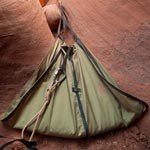 |
Sandtrap | |
 |
Scrambling | Easy climbing, usually without a rope. |
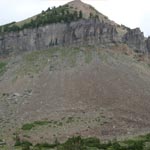 |
Scree | Loose rocks and stones that cover the slope below a cliff. |
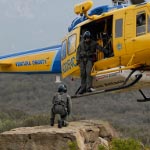 |
Search & Rescue, SAR | The people who put their life on the line when you screw up. |
| Siege Style | (Expedition Style) canyoneering involves setting up fixed ropes, fixing lines of retreat, providing rim support crews to extract or help if the route becomes difficult. | |
 |
Sling | What Americans call a runner. |
 |
Slogging | The extremely tedious and monotonous cross-country travel on foot to get tot he canyon or get back to the car. ex. Moroni Slopes, Choprock bench |
| Smearing | Foot technique where a big part of the shoe is used to generate as much friction as possible | |
| Social Trail | An unplanned and undesirable trail, often with multiple paths weaving over each other. | |
| Softman | A former hardman who can accomplish canyons of epic proportion inc om fort able style. Always has the warmest jacket, the biggest sleeping pad, the best food, and the finest of consumables. A title to aspire for. | |
| Soloing | Canyoneering alone without a partner. | |
| SRT | Single Rope Technique. | |
| Stem | Bridging with the feet between two holds. | |
 |
Stemming | Involves a hand and foot on each side - a symmetric approach. Usually facing forward. |
| Subway | Is a wide section underneath a Mae West slot. A subway allows for easy passage under a Mae West. | |
| Swami | A climbing harness constructed from webbing. | |
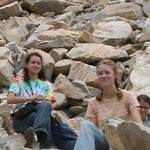 |
Talus | Large blocks of rock. A coarse variation of scree. |
| Teva's | River rafting footwear or sandal. | |
| Third Class | Climbing without a rope on easy ground. | |
| Traverse | Horizontal climbing. | |
| Truck | A very solid anchor, i.e. able to hold a truck. Synonym to bomb-proof. | |
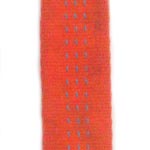 |
Webbing | Strong flat strip of nylon. |
| X rating | Extreme. A subjective rating system used to rate canyons that are made more hazardous than an average canyon by the presence of bombays, keeper potholes, dangerous and/or exposed downclimbing, long exposure to cold water,and/or the need for advanced ropework in order to safely descend. A major mishap will result in death. | |
| YDS | Yosemite Decimal System. The North-American climbing rating system. | |
| Zip Line | A method of transporting gear (usually heavy packs, or other objects that are to be kept dry) to the bottom of a rappel that terminates in deep water. The zip line consists of a taut rope, and begins at the top of the drop, and ends at the base of the rappel, just clear of the water obstacle. | |